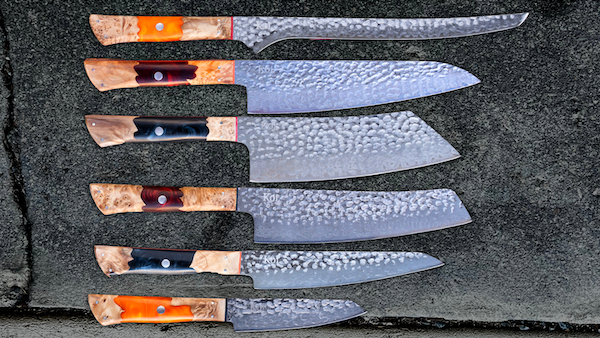If you've ever wondered why some knives hold up better under hard use than others, you're in the right place. Today, we're looking at tang types – a crucial factor in determining a knife's strength and resilience. From full tang to partial tang, we'll examine how these designs impact your knife's ability to handle tough tasks like prying and chopping.
So, whether you're a seasoned chef, an outdoor lover, or simply someone who values quality tools, follow to learn factors that contribute to the durability of a knife.
What Is a Full Tang Knife?
A full tang knife isn't just a regular blade – it's a powerhouse. Imagine the blade material extending all the way through the handle, creating a seamless integration of strength and functionality. This design ensures that the blade and handle work together as one, providing unique balance and resilience. When you're dealing with tough tasks like prying or chopping, a full tang knife is there, ready to tackle the challenge without hesitation.
Difference between Full Tang and Partial Tang Knives
Now, let's compare the full tang with its counterpart, the partial tang. Imagine the partial tang knife as a lighter, more agile choice. Unlike its full-tang sibling, a partial tang knife has no blade material extending through the handle. Instead, it balances functionality and convenience, making it suitable for everyday tasks where brute force isn't required.
While both types have their strengths and weaknesses, understanding their distinctions helps in selecting the right tool for the job.
Performance Testing: Prying and Chopping.
Durability is the backbone of any reliable tool, especially in demanding situations. Knives can undergo various durability tests to ensure they can withstand the challenges they'll face in the field.
Prying Tests
Prying is a common task where the strength and resilience of a knife's tang type truly come into play. Knives are subjected to prying tests to assess their ability to exert force without breaking or bending. This involves applying pressure to the knife blade in different directions to simulate real-world prying scenarios.
Chopping Tests
Chopping is another fundamental task that knives are expected to perform efficiently. Chopping tests evaluate a knife's edge retention, blade geometry, and overall performance when tackling dense materials.
Performance Evaluation
During these tests, knives are evaluated based on their ability to maintain sharpness, resist chipping or deformation, and handle repeated stress. With their robust construction, full-tang knives excel in prying and chopping tasks, offering unmatched durability and stability under pressure.
Showcase of Osaka Collection for Various Tasks
The Osaka Collection boasts a range of knives designed to tackle various culinary tasks precisely and easily. Let's look at each knife in the collection and its specific applications.
Knife Specifications and Uses
- Hammered Gyuto: This versatile chef's knife is the kitchen's workhorse, excelling in chopping, slicing, and dicing. With a blade length of 220mm and a height of 49mm, it offers the perfect balance of power and precision for all your culinary endeavors.
- Hammered Utility: Slightly smaller than the Gyuto, the Utility knife is ideal for tasks that require more finesse, such as slicing fruits, vegetables, and herbs. Its 185mm blade length and 35mm height make it a go-to choice for everyday kitchen tasks.
- Hammered Paring: The Paring knife shines in intricate cutting tasks like peeling fruits or deveining shrimp. With a blade length of 128mm and a height of 30mm, it offers exceptional control and maneuverability for delicate work.
- Hammered ‘Jamon’ Slicer: Designed for precision slicing, the Jamon Slicer excels in carving meats, slicing sushi, and tackling large cuts of meat easily. Its long, slender blade (278mm) and low profile (20mm) make it the perfect tool for achieving paper-thin slices.
- Hammered Veg Chopper: As the name suggests, this knife is a powerhouse for chopping vegetables. With a longer blade length of 210mm and a height of 50mm, it effortlessly tackles everything from onions and tomatoes to larger vegetables like cabbage and watermelon.
- Hammered Bunka: The knife is the ultimate all-purpose chopper, excelling in tasks requiring power and precision. With a blade length of 196mm and a height of 58mm, it effortlessly glides through starchy vegetables and proteins, making it a versatile addition to any kitchen arsenal.
Blade Perfection: Three Steps to Excellence
The Osaka Collection knives undergo a precise three-step process for blade perfection: Slice, Slide, and Separate. Firstly, the blade's VG10 steel edge boasts a sharp 15-degree angle for effortless slicing.
Secondly, 33 layers of steel on each side allow ingredients to glide smoothly, enhanced by a layer of nickel for visual appeal. Finally, hammered ripples near the spine create air pockets, aiding in ingredient separation. This process ensures exceptional cutting performance and durability, making Osaka Collection knives indispensable in any kitchen.
Owning Your Osaka Collection
- Complete Osaka 6 Set: Experience the full range of Osaka knives with this comprehensive set, including all six knives for ultimate versatility in the kitchen.
- 3-Piece Hammered Starter Kit: Start your culinary journey with this essential starter kit featuring the versatile Bunka, the workhorse Gyuto, and the precise Paring knife.
- 3-Piece Set: Perfect for vegetable enthusiasts, this set includes the Veg Chopper for tackling all your chopping needs, the ‘Jamon’ Slicer for precision slicing, and the Utility knife for versatile daily tasks.
Artistry and Practicality of Blade Ripples on Osaka Knives
Blade ripples, or "tsuchime" in Japanese, are the mesmerizing undulating patterns on Osaka knives achieved through meticulous hammering, known as the "hammered finish." Beyond aesthetics, these ripples serve a practical purpose by creating tiny air pockets that reduce food sticking to the blade during slicing.
This functionality enhances the dining experience, allowing for smoother, cleaner cuts. Crafting these ripples requires skilled metallurgy and precise hammering techniques, ensuring the blade's practicality and longevity. Thus, the art of blade ripples adds beauty to Osaka knives and elevates their performance, making them indispensable tools in the kitchen.




